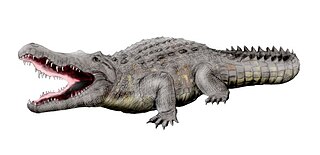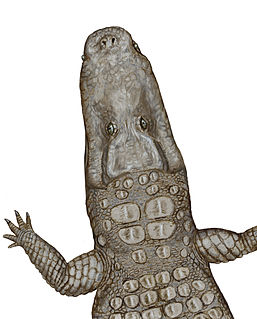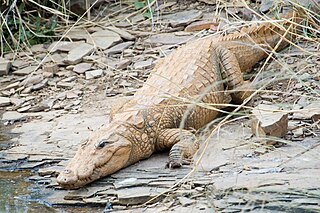 W
WThe crocodylian family Crocodylidae includes the true crocodiles, which are the members of the subfamily Crocodylinae, as well as potentially the false gharial, the only extant member of the subfamily Tomistominae. The latter is a subject of controversy as to whether it is a crocodile or actually belongs in the family Gavialidae. Further genetic analysis has to be done to come to a final conclusion.
 W
WThe Central African slender-snouted crocodile is one of two species of crocodiles in the genus Mecistops. It was once thought to be a population of the West African slender-snouted crocodile but was elevated to a species after two detailed studies, one in 2014 and the other in 2018.
 W
WCrocodiles or true crocodiles are large semiaquatic reptiles that live throughout the tropics in Africa, Asia, the Americas and Australia. Crocodylinae, all of whose members are considered true crocodiles, is classified as a biological subfamily. A broader sense of the term crocodile, Crocodylidae, is not used in this article. The term crocodile here applies to only the species within the subfamily of Crocodylinae. The term is sometimes used even more loosely to include all extant members of the order Crocodilia, which includes the alligators and caimans, the gharial and false gharial, and all other living and fossil Crocodylomorpha.
 W
WThe Cuban crocodile is a small-medium species of crocodile found only in Cuba. Typical length is 2.1–2.3 m (6.9–7.5 ft) and typical weight 70–80 kg (150–180 lb). Large males can reach as much as 3.5 m (11 ft) in length and weigh more than 215 kg (474 lb). Despite its modest size, it is a highly aggressive animal, and potentially dangerous to humans.
 W
WThe Crocodyloidea superfamily of crocodilians evolved in the Late Cretaceous period. Cladistically, it is defined as Crocodylus niloticus and all crocodylians more closely related to C. niloticus than to either Alligator mississippiensis or Gavialis gangeticus.
 W
WCrocodylus is a genus in the family Crocodylidae. The scientific name was proposed by Josephus Nicolaus Laurenti in 1768.
 W
WThe American crocodile is a species of crocodilian found in the Neotropics. It is the most widespread of the four extant species of crocodiles from the Americas, with populations present from South Florida and the coasts of Mexico to as far south as Peru and Venezuela.
 W
WThe American crocodile is a species of crocodilian found in the Neotropics. It is the most widespread of the four extant species of crocodiles from the Americas, with populations present from South Florida and the coasts of Mexico to as far south as Peru and Venezuela.
 W
WCrocodylus anthropophagus is an extinct species of crocodile from the Pleistocene of Tanzania. It lived 1.84 million years ago. It was a large-sized predator reaching a length of 5 m (16 ft).
 W
WCrocodylus checchiai is an extinct species of crocodile from the Pliocene of Libya and the Miocene of Kenya. C. checchiai was named in 1957 from the Sahabi Formation. It is similar in appearance to the Nile crocodile C. niloticus and may even be the same species. Remains from the lower Nawata Formation in the Turkana Basin of Kenya that were first attributed to the Nile crocodile have now been reassigned to C. checchiai, extending its geographic and temporal range.
 W
WCrocodylus thorbjarnarsoni is an extinct species of crocodile from the Pliocene and Pleistocene of the Turkana Basin in Kenya. It is closely related to the species Crocodylus anthropophagus, which lived during the same time in Tanzania. C. thorbjarnarsoni could be the largest known true crocodile, with the largest skull found indicating a possible total length up to 7.6 m (25 ft). It may have been a predator of early hominins. Crocodylus thorbjarnarsoni was named by Christopher Brochu and Glenn Storrs in 2012 in honor of John Thorbjarnarson, a conservationist who worked to protect endangered crocodilians.
 W
WThe dwarf crocodile, also known as the African dwarf crocodile, broad-snouted crocodile or bony crocodile, is an African crocodile that is also the smallest extant (living) species of crocodile. Sampling has identified three genetically distinct populations. Some feel that the findings should elevate the subspecies to full species status.
 W
WThe freshwater crocodile, also known as the Australian freshwater crocodile, Johnstone's crocodile or colloquially as freshie, is a species of crocodile endemic to the northern regions of Australia.
 W
WMecistops is a genus of crocodiles, the slender-snouted crocodiles, native to sub-Saharan Africa.
 W
WMorelet's crocodile (Crocodylus moreletii), also known as the Mexican crocodile, is a modest-sized crocodilian found only in fresh waters of the Atlantic regions of Mexico, Belize and Guatemala. It usually grows to about 3 metres (9.8 ft) in length. It is a Least Concern species. The species has a fossil record in Guatemala.
 W
WThe mugger crocodile, also called marsh crocodile, broad-snouted crocodile and mugger, is a crocodilian native to freshwater habitats from southern Iran to the Indian subcontinent. It is extinct in Bhutan and Myanmar and has been listed as Vulnerable on the IUCN Red List since 1982.
 W
WThe New Guinea crocodile is a small species of crocodile found on the island of New Guinea north of the mountain ridge that runs along the centre of the island. The population found south of the mountain ridge, formerly considered a genetically distinct population, is now considered a distinct species, Hall's New Guinea crocodile. In the past it included the Philippine crocodile, C. n. mindorensis, as a subspecies, but today they are regarded as separate species. The habitat of the New Guinea crocodile is mostly freshwater swamps and lakes. It is most active at night when it feeds on fish and a range of other small animals. A female crocodile lays a clutch of eggs in a nest composed of vegetation and she lies up nearby to guard the nest. There is some degree of parental care for newly hatched juveniles. This crocodile was over-hunted for its valuable skin in the mid 20th century, but conservation measures have since been put in place, it is reared in ranches and the International Union for Conservation of Nature (IUCN) lists it as being of "Least Concern".
 W
WThe Nile crocodile is a large crocodilian native to freshwater habitats in Africa, where it is present in 26 countries. Due to its widespread occurrence and stable population trend, it has been listed as Least Concern on the IUCN Red List since 1996. It is widely distributed throughout sub-Saharan Africa, occurring mostly in the central, eastern, and southern regions of the continent, and lives in different types of aquatic environments such as lakes, rivers, swamps, and marshlands. Although capable of living in saline environments, this species is rarely found in saltwater, but occasionally inhabits deltas and brackish lakes. The range of this species once stretched northward throughout the Nile, as far north as the Nile delta. On average, the adult male Nile crocodile is between 3.5 and 5 m in length and weighs 225 to 750 kg . However, specimens exceeding 6.1 m (20 ft) in length and weighing up to 1,089 kg (2,400 lb) have been recorded. It is the largest freshwater predator in Africa, and may be considered the second-largest extant reptile in the world, after the saltwater crocodile. Sexual dimorphism is prevalent, and females are usually about 30% smaller than males. They have thick, scaly, heavily armoured skin.
 W
WThe Orinoco crocodile is a critically endangered crocodile. Its population is very small and it can only be found in freshwater environments in Colombia and Venezuela, in particular the Orinoco river and its tributaries. Extensively hunted for their skins in the 19th and 20th centuries, this species is one of the most critically endangered species of crocodiles. It is a very large species of crocodilian and predator in the Americas. Males have been reported up to 6.8 m in the past, but such sizes do not exist today, 5.2 m being a more widely accepted maximum size. A large male today may attain 4.1 m in length and can weigh 380 kg (840 lb), while females are substantially smaller with the largest likely to weigh around 225 kg (496 lb). Sexual dimorphism is not as profound as in some other species. The coloration is light even in adults.
 W
WThe Philippine crocodile, also known as the Mindoro crocodile, the Philippine freshwater crocodile, the bukarot in Ilocano, and more generally as a buwaya in most Filipino lowland cultures, is one of two species of crocodiles found in the Philippines; the other is the larger saltwater crocodile (Crocodylus porosus). The Philippine crocodile, the species endemic only to the country, became data deficient to critically endangered in 2008 from exploitation and unsustainable fishing methods, such as dynamite fishing. Conservation methods are being taken by the Dutch/Filipino Mabuwaya foundation, the Crocodile Conservation Society and the Zoological Institute of HerpaWorld in Mindoro island. It is strictly prohibited to kill a crocodile in the country, and it is punishable by law.
 W
WThe saltwater crocodile is a crocodilian native to saltwater habitats and brackish wetlands from India's east coast across Southeast Asia and the Sundaic region to northern Australia and Micronesia. It has been listed as Least Concern on the IUCN Red List since 1996. It was hunted for its skin throughout its range up to the 1970s, and is threatened by illegal killing and habitat loss. It is regarded as dangerous for people who share the same environment.
 W
WThe Siamese crocodile is a medium-sized freshwater crocodile native to Indonesia, Brunei, East Malaysia, Laos, Cambodia, Myanmar, Thailand and Vietnam. The species is critically endangered and already extirpated from many regions. Its other common names include Siamese freshwater crocodile, Singapore small-grain, and soft-belly.
 W
WVoay is an extinct genus of crocodile from Madagascar and includes only one species—V. robustus. Numerous subfossils have been found, including complete skulls as well as vertebrae and osteoderms from such places as Ambolisatra and Antsirabe. The genus is thought to have become extinct relatively recently during the Holocene. It has even been suggested to have disappeared in the extinction event that wiped out much of the endemic megafauna such as the elephant bird following the arrival of humans to Madagascar around 2000 years ago. Its name comes from the Malagasy word for crocodile.
 W
WThe West African crocodile, desert crocodile, or sacred crocodile is a species of crocodile related to – and often confused with – the larger and more aggressive Nile crocodile.
 W
WThe West African slender-snouted crocodile is a critically endangered species of African crocodile. It is one of five species of crocodile in Africa, the other four being the Central African slender-snouted, Nile, West African and dwarf crocodiles.